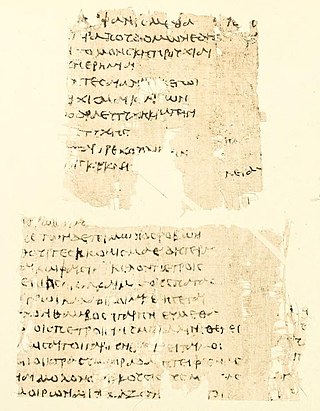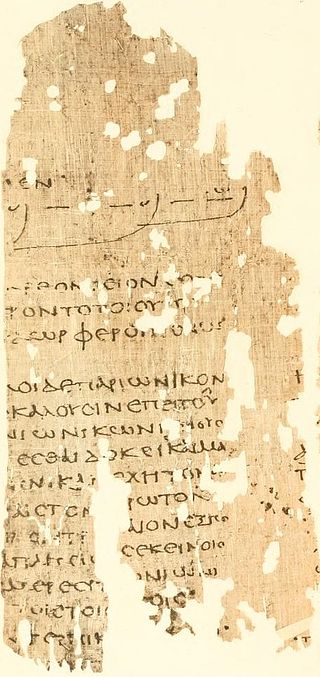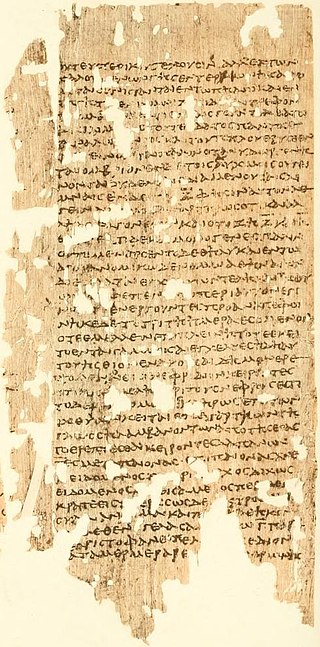Related Research Articles

Papyrus Oxyrhynchus 211 is a fragment of the Perikeiromene (976–1008) of Menander, written in Greek. It was discovered in Oxyrhynchus. The manuscript was written on papyrus in the form of a roll. It is dated to the first or second century. Currently it is housed in the Houghton Library (3734) of Harvard University.
Papyrus Oxyrhynchus 212 consists of three fragments of a comedy of Aristophanes, written in Greek. It was discovered in Oxyrhynchus. The manuscript was written on papyrus in the form of a roll. It is dated to the first or second century. Currently it is housed in the British Library in London.

Papyrus Oxyrhynchus 213 consists of two fragments of a tragedy by an unknown author, written in Greek. It was discovered in Oxyrhynchus. The manuscript was written on papyrus in the form of a roll. It is dated to the second century. Currently it is housed in the British Library in London.
Papyrus Oxyrhynchus 214 is a fragment of an epic by an unknown author, written in Greek. It was discovered in Oxyrhynchus. The manuscript was written on papyrus in the form of a codex. It is dated to the third century. Currently it is housed in the British Library in London.
Papyrus Oxyrhynchus 215 is a philosophical fragment by an unknown author, written in Greek. It was discovered in Oxyrhynchus. The manuscript was written on papyrus in the form of a roll. It is dated to the first century BC or first century AD. Currently it is housed in the British Library in London.
Papyrus Oxyrhynchus 217 is a letter to a king of Macedon by an unknown author, written in Greek. It was discovered in Oxyrhynchus. The manuscript was written on papyrus in the form of a roll. It is dated to the third century AD. Currently it is housed in the Cambridge University Library (35) in Cambridge.
Papyrus Oxyrhynchus 218 is a historical fragment by an unknown author, written in Greek. It was discovered in Oxyrhynchus. The manuscript was written on papyrus in the form of a roll. It is dated to the third century AD. Currently it is housed in the British Library in London.

Papyrus Oxyrhynchus 220 is a treatise on prosody, written by an unknown author in Greek. It was discovered in Oxyrhynchus. The manuscript was written on papyrus in the form of a roll. It is dated to the first century or second century AD. Currently it is housed in the British Library in London.

Papyrus Oxyrhynchus 221 contains Homeric scholia by an unknown author, written in Greek. It was discovered in Oxyrhynchus, Egypt. The manuscript was written on papyrus in the form of a roll. It is dated to the second century. Frederic G. Kenyon dated it to the first century or the first half of the second century. Currently it is housed in the British Library in London.
Papyrus Oxyrhynchus 223 is a fragment of Homer's Iliad (E,329-705), written in Greek. It was discovered in Oxyrhynchus. The manuscript was written on papyrus in the form of a roll. It is dated to the third century. Currently it is housed in the Bodleian Library in Oxford.
Papyrus Oxyrhynchus 224 is a fragment of the Phoenissae, a tragedy of Euripides, written in Greek. It was discovered in Oxyrhynchus. The manuscript was written on papyrus in the form of a roll. It is dated to the third century. Currently it is housed in the British Library in London.
Papyrus Oxyrhynchus 225 is a fragment of Thucydides (II,90-91), written in Greek. It was discovered in Oxyrhynchus. The manuscript was written on papyrus in the form of a roll. It is dated to the first century. Currently it is housed in the British Library in London.
Papyrus Oxyrhynchus 226 is a fragment of the Hellenica (VI,5) of Xenophon, written in Greek. It was discovered in Oxyrhynchus. The manuscript was written on papyrus in the form of a roll. It is dated to the first or second century. Currently it is housed at Columbia University in New York City.
Papyrus Oxyrhynchus 227 is a fragment of the Oeconomicus of Xenophon, written in Greek. It was discovered in Oxyrhynchus. The manuscript was written on papyrus in the form of a roll. It is dated to the first century. Currently it is housed in the British Library in London.
Papyrus Oxyrhynchus 229 is a fragment of the Phaedo, a dialogue by Plato, written in Greek. It was discovered in Oxyrhynchus. The manuscript was written on papyrus in the form of a roll. It is dated to the second or third century. Currently it is housed in the British Library in London.
Papyrus Oxyrhynchus 230 is a fragment of the De Corona by Demosthenes, written in Greek. It was discovered in Oxyrhynchus. The manuscript was written on papyrus in the form of a roll. It is dated to the second century. Currently, it is housed in the Milton S. Eisenhower Library of the Johns Hopkins University in Baltimore.
Papyrus Oxyrhynchus 231 is a fragment of the De Corona by Demosthenes, written in Greek. It was discovered in Oxyrhynchus. The manuscript was written on papyrus in the form of a roll. It is dated to the second or third century. Currently it is housed in the Cambridge University Library in Cambridge.
Papyrus Oxyrhynchus 232 is a fragment of Contra Timocratem by Demosthenes, written in Greek. It was discovered in Oxyrhynchus. The manuscript was written on papyrus in the form of a roll. It is dated to the second or third century. Currently it is housed in the British Library in London.
Papyrus Oxyrhynchus 257 is a fragment of a census return, in Greek. It was discovered in Oxyrhynchus. The manuscript was written on papyrus in the form of a sheet. It is dated to the year 94-95. The owner of the fragment and the place of its current housing is unknown.
Papyrus Oxyrhynchus 289 is a fragment containing taxation accounts, in Greek. It was discovered in Oxyrhynchus. The manuscript, written on papyrus in the form of a sheet, was written after 26 January 83. Currently it is housed in the British Library in London.
References
- ↑ P. Oxy. 216 at the Oxyrhynchus Online
- 1 2 Grenfell, B. P.; Hunt, A. S. (1898). Oxyrhynchus Papyri II. London: Egypt Exploration Fund. pp. 33–34.
![]() This article incorporates text from a publication now in the public domain: B. P. Grenfell; A. S. Hunt (1899). Oxyrhynchus Papyri II. London: Egypt Exploration Fund.
This article incorporates text from a publication now in the public domain: B. P. Grenfell; A. S. Hunt (1899). Oxyrhynchus Papyri II. London: Egypt Exploration Fund.